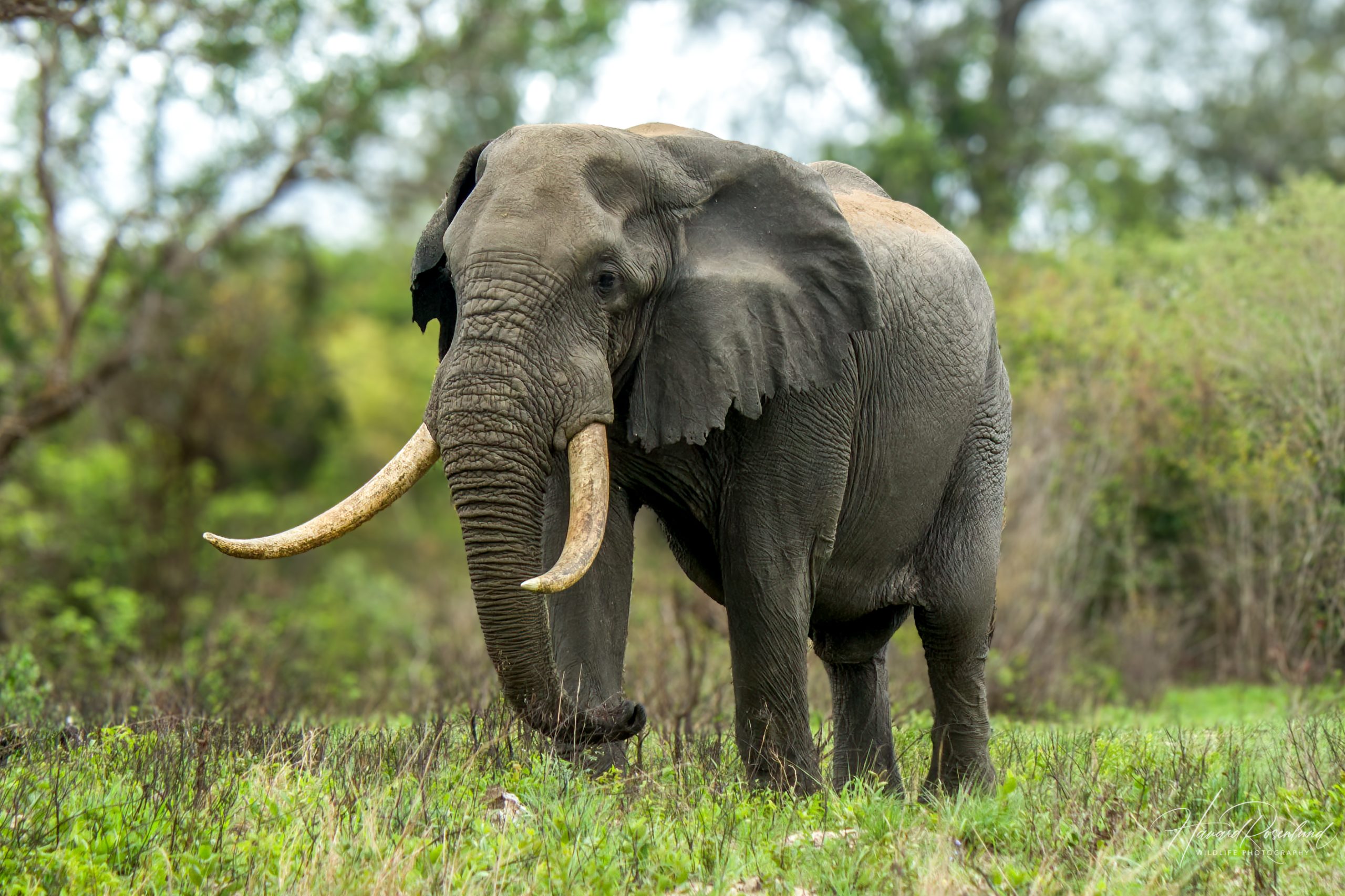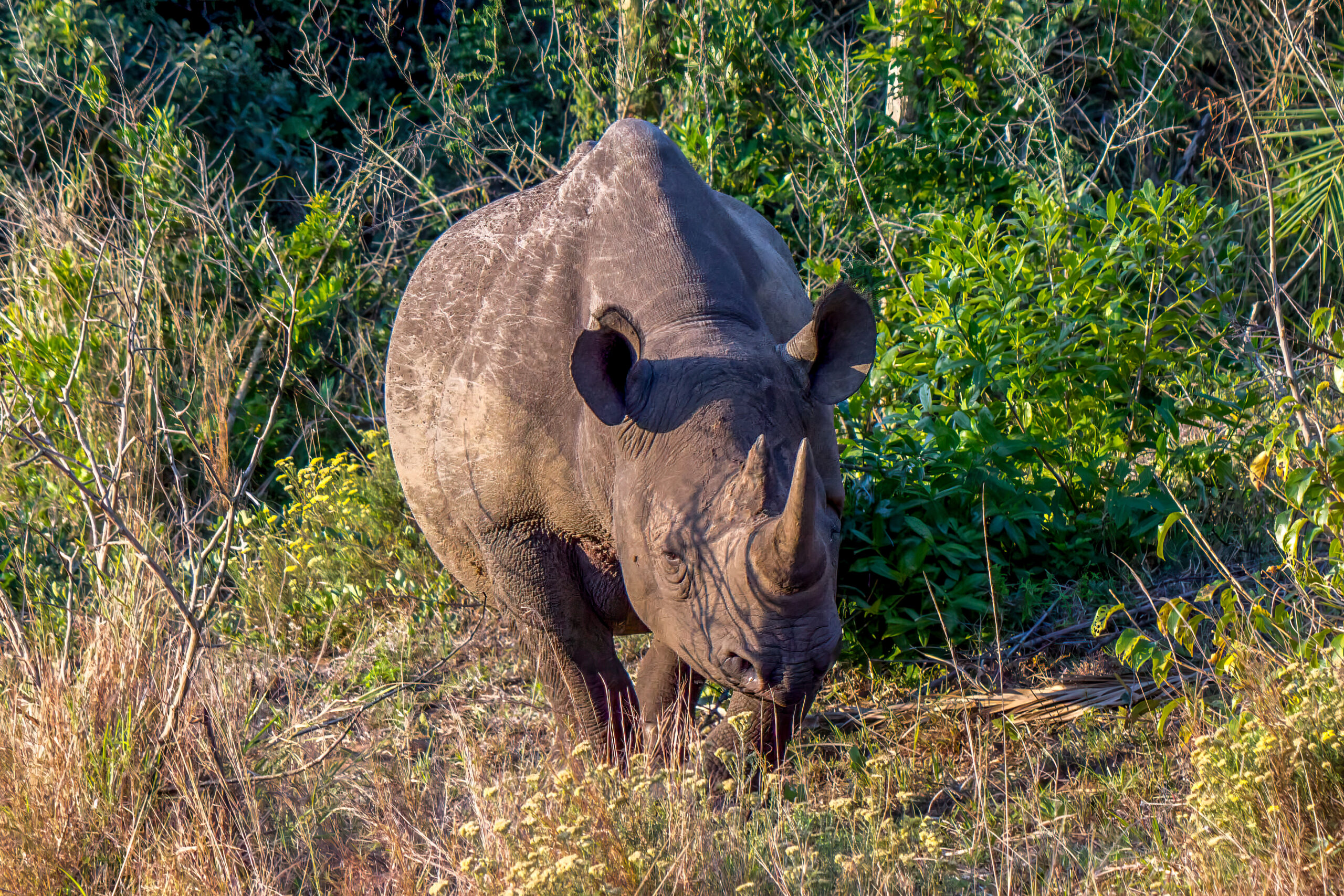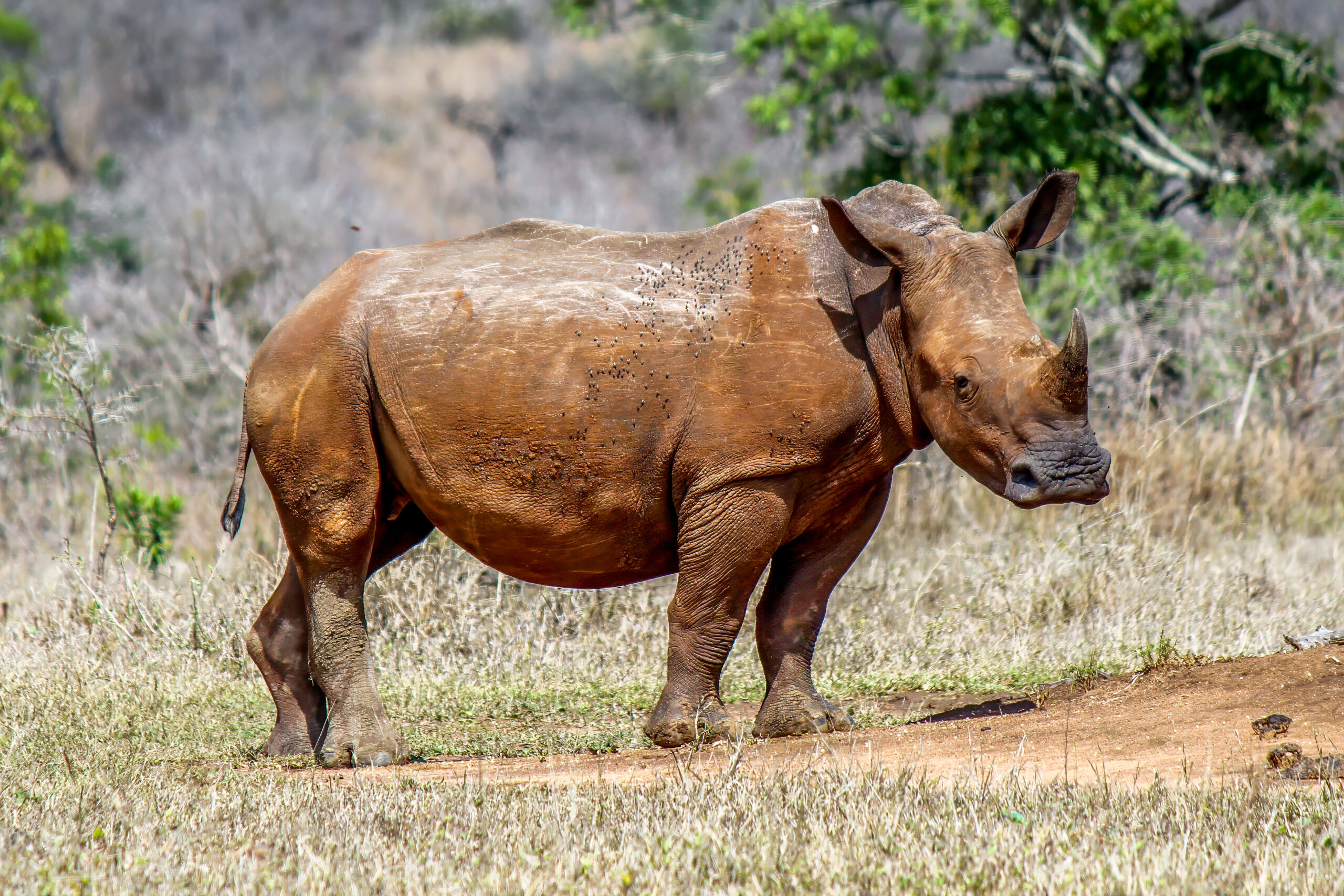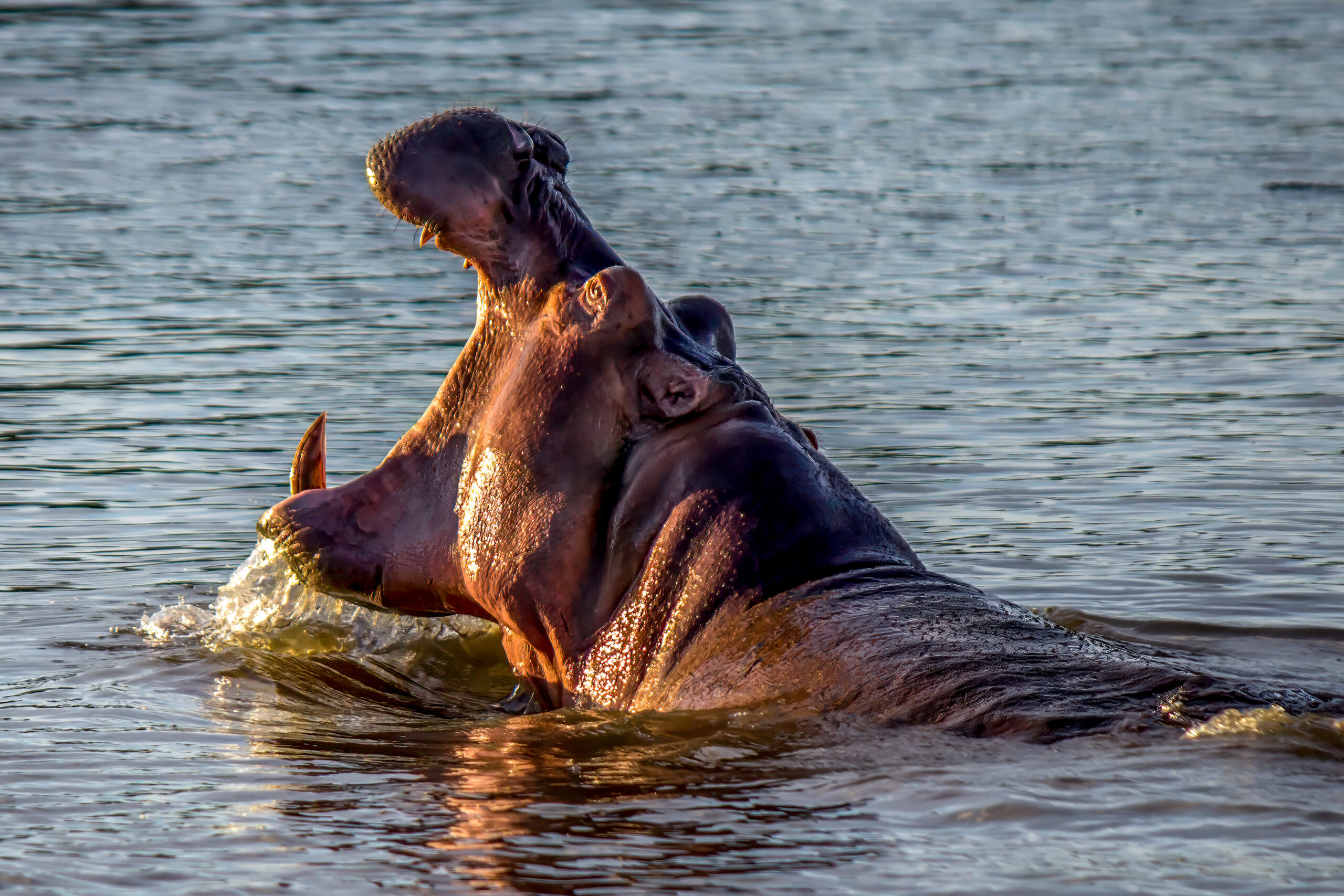Description
The African bush elephant (Loxodonta africana), or savanna elephant, is the largest land animal. Big bulls can reach heights of 4 meters (13 feet) and weights up to 10 metric tons (22,000 lb), though 5-6 tons (11,000 – 13,200 lb) is more common. Females are much smaller at around 2.5 meters (8-9 feet) at the shoulder and a weight between 2-3 tons (4400 – 6600 lb). Due to genetic studies the African elephant is now split into two separate species. The bush elephant is the largest and the most common one, while the forest elephant (L. cyclotis) is noticeably smaller, with straighter tusks and rounder ears. Forest elephants are mainly found in Central Africa and the West African rain forest regions, while the bush species is found in savanna regions in East, West, and Southern Africa, though some postulate the West African specimens might be a third species.
Social behavior & reproduction
Elephants are highly intelligent animals living in social family groups led by a female leader, the matriarch. Females stay in their native herd their entire lives, making everyone in the herd closely related. A herd can split into smaller herds, and then rejoin again at later stages. It is not uncommon when resources are abundant to find small groups with one mother, one or several older daughters, and a few calves temporarily split from the bigger herd. In the dry season, family groups often get together for protection, and in some instances, they can reach up to several hundred individuals. A female can start reproducing offspring at age 10-12 and will be in estrus for only 2-7 days at a time. Once impregnated, the gestation period is 22 months.
The elephant bulls live with the herd until they reach an age of around 14 years before they split from the herd to venture on their own. Bulls live most of their adult life alone, but they often form bachelor groups that will stick together for longer periods. It is common for a young bull to find a bachelor group with older bulls. The older bulls will teach the younger elephant the ways of living as an adult elephant.
Here’s a video of an elephant herd with a very young calf. Notice how the females always try to keep the calf protected and hidden away. The matriarch in this herd has no tusks, a trait thought to be more common in areas with a history of poaching. Take notice when the big bull comes in (the one with the branch stuck on his back) how much larger he is than the females.

Musth
Bull elephants will throughout their adult lives go through periods of hormonal change, called musth, where their testosterone levels increase to 60 times the normal levels. During musth an elephant becomes highly aggressive and dangerous. It is thought to be linked with dominance and sexual arousal, though research have been inconclusive as to what is the main cause. The presence of bigger and older bulls will normally keep younger and less dominant individuals from entering musth prematurely. All bull elephants will go into musth periodically during their prime adult years of 25-45 when they reach a size where they can fight other bulls for mating rights and dominance. Musth can last from one day to four months.
It is possible to identify a bull in musth by looking at the temporal ducts situated behind the eyes on both sides of the head. During musth, an elephant will secrete large quantities of a substance called temporin, and can be seen as a wide, wet flow running down from the ducts. In addition, the elephant will have urine constantly dripping from his penis that may or may not be out of its pouch. An elephant in musth will also walk with the head held high and swinging, and he will sometimes dig his tusks into the ground. Always look for these signs when coming across bull elephants as it may save lives, or at least your vehicle.
Fighting
When big bulls fight for dominance, it can be brutal, and can sometimes end with death of the less dominant individual. All bulls will throughout their lives test their strength by fighting other bulls, including companions within the bachelor herds. Even when not in musth they will always try to assert dominance. In the video below there’s an excellent example of two bulls testing their strength and dominance. Notice how the two very young bulls beside try to mimic them. It is also important to note how the fight suddenly comes to a halt when the dominant bull enters the scene towards the end.

Old age
Elephants live to become 45-60 years of age. How old they become is dependent on their teeth. An elephant has four molars, and as the front ones are worn down by use, the back ones are pushed forward. Elephants will have their teeth replaced 4-6 times during their lifetime. As they get older and their last set of teeth are getting worn down, they will forage on vegetation that is easier to chew. Because of this, elephants often go to the same foraging spots before they die. This has created the rumor of elephant graveyards.
Intelligence
Elephant intelligence is thought to be on the same level as whales and dolphins, as well as primates. They can show a wide range of emotions, such as grief, joy and compassion. They are self-aware and their ability to learn, use tools and solve problems are astounding. They might even have their own language, as they can communicate over long distances using low-frequency vibrations in the ground.
Status & threats
As of 2016 the number of African bush elephants were thought to be just above 350,000. The number has been fluctuating a lot over the last couple of centuries with periods of intense poaching for ivory and meat. Habitat loss and poaching has been major problems for the West African elephant and the forest elephant, especially.
In 2013, an estimate of 23,000 African elephants were killed in poaching incidents, and another 20,000 in 2014. In a span of just one decade, from mid-2000’s to mid-2010’s, 111,000 individuals were thought to be killed by poaching alone. Efforts to mitigate the situation has since been in place, and poaching has now been on a downward trend, with the numbers of elephants killed thought to be decreasing each year. East Africa has been the region with the highest poaching rates, and it’s due to efforts in countries here that see the bush elephants on a less drastic downward trend.
Southern Africa has not seen as much elephant poaching as the rest of the continent, with a slow but steady increase in numbers and a total population of just below 300,000. Elephants have been doing well in this region for some time. Inside a few parks and reserves, such as Kruger National Park, because of fences and the lack of corridors between reserves, there have instead been trends towards an overpopulation. Too many elephants with no place to go can possibly destroy ecosystems due to their impact on the environment. Many reserves try to solve this by contraception, a way of giving birth control to female elephants. This has shown to be quite successful most places.
Even though poaching is decreasing, and elephants in Southern Africa seem to be doing better than the rest, the African bush elephant is not out of the woods yet. Habitat loss and expansion of human development is thought to increase as human numbers continue to grow in many parts of Africa, which is a major threat to elephants that need large natural areas to roam.
Another threat that has already seen a major negative impact on some elephant populations is the extreme droughts occurring in large parts of Africa due to climate change. Such droughts are only thought to increase in severity, possibly making some areas populated by elephants now uninhabitable in the future.
Because of the threats that still face the African bush elephants, and will continue to do so, it is listed as endangered on the IUCN Red List.




















